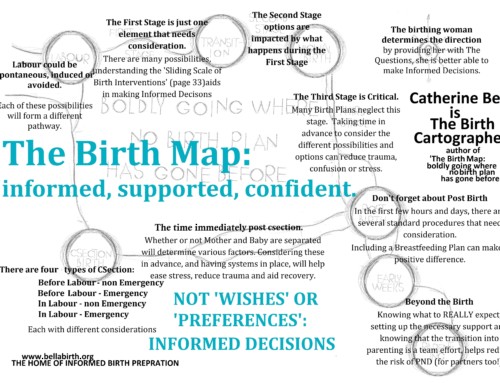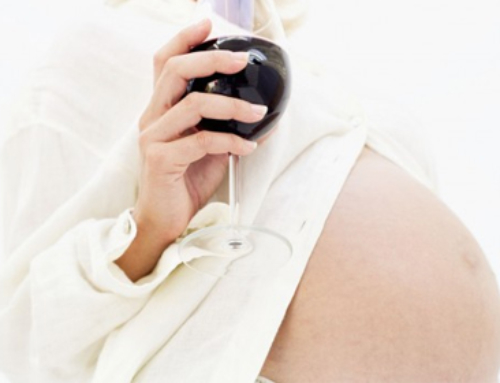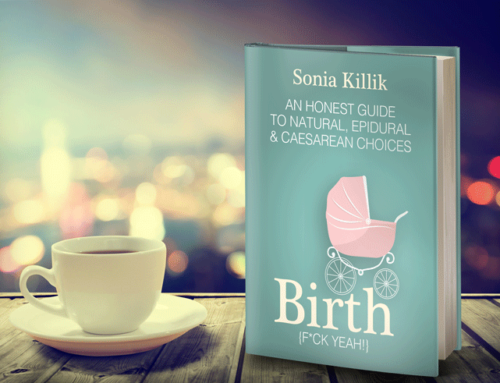By Tracy G. Cassels
We’re at a crossroads here in North America when it comes to family in many ways. The recent TIME article on Attachment Parenting seemed to add fuel to a fire already burning amongst parents, doctors, and “experts” alike about the “best” way to raise your children. This fight, however, is nothing compared to the one that has been fought for years about birth. You see, while we can debate the merits of co-sleeping versus room-sharing versus a crib, we know that for many, whatever parents decide is being decided because it works for them and their family. But birth? The accusations that fly around have some very strong language and consequences attached to them.
In one corner we have the traditional idea of birth: women with midwives, typically in a home setting, giving birth without drugs or medical intervention. In the other corner we have our more Westernized idea of birth: women with doctors, in a hospital, with myriad interventions to reduce pain and change the natural course of labour. And while nearly all people in the first camp acknowledge the role of medicine to make labour safer in some circumstances, many in the second camp see no benefit at all to the traditional labour and birth and in fact have argued it’s dangerous to mom and baby. And there are some studies to suggest there may be something to that, but if you actually look at these studies more closely (see Fighting for Homebirth), you see that the risks aren’t really about homebirth per se, but about the presence versus absence of a trained midwife (or family doctor) or the distance to the nearest hospital in case of an emergency.
So here we sit, with homebirth on the rise, but still accounting for a minuscule proportion of births in general. Birthing centres are starting to pop up in various Western nations, a nice blend of the traditional and modern environments, but there are too few to really count. Currently the vast majority of births are in hospital settings with doctors overseeing them. And according to the view that traditional labour and birth are dangerous to mom and baby, this current system of medicalized birth should be yielding amazing results with respect to maternal and infant mortality and morbidity. At least, that’s the logical thing to argue.
But it’s not.
You see, the WHO released their 2012 Trends in Maternal Mortality review recently and it’s eye-opening to say the least. Yes, there are countries who have such awful maternal mortality rates that we obviously can see the benefit of living in a Western nation. But it’s asinine to assume that the only difference is homebirth versus hospital birth. Take Afghanistan, which is first on the list (it’s alphabetical) and though it’s maternal mortality rate has dropped from 1300/100,000 live births in 1990 to 460/100,000 live births in 2010, that’s still far too many mothers dying. When you compare that to Canada, with a 2010 rate of 12/100,000 we see that we have something going on that’s better. But it’s not all about the hospitals. We have greater access to health care overall, better sanitation, better food and cleaner water. These, and more, are the main reasons our numbers are so low. And yes, we do have hospitals for when things go wrong.
So if we just look at the numbers as they are, we can be pretty happy with our current maternal mortality rates. IF we just look at the numbers as they are. But that would be silly. Because there’s a story in these numbers that is actually quite disturbing.
Here are the numbers in five year intervals for some Western countries 1990 1995 2000 2005 2010 6 7 7 11 12 7 5 5 6 5 13 13 10 8 8 10 12 13 8 6 10 10 12 13 12 12 12 14 18 21 The UK, Canada, and US aren’t improving maternal mortality rates, they’re getting worse. And in nations with that much wealth, it’s unforgivable. The UK shows a modest 20% increase over the past 20 years while the US numbers have risen 75%, and finally Canada’s have doubled. Doubled. Twenty years ago Canada had rates that were incredible. And while the rates are still better than most (just like the UK and the US), unlike most, we’re heading in the wrong direction. But why? Let’s first look at the number of c-sections and home births being performed in each of these countries from the latest OECD data (2009): C-Section Rate (per 100 live births)[2] Homebirth Rate (%)* Midwife Attended Births (%)[3] 26.6 <2 6.1 15.7 <1** 75 20.0 <1 – 14.3 33 70 23.7 3 70 32.3 <1 8 *Taken from various sources and sites and thus the accuracy may be off. **Somewhat misleading as they have many hospitals whose maternity wards are focused on natural, active birth so most people don’t feel they need to be at home to avoid interventions. My own take on this data is that there’s a bit of a confluence of factors affecting maternal mortality rates. Just having a lower c-section rate isn’t the only thing, but having midwives actively involved in the process and birth settings in which natural, active birth is promoted is also helpful. And very clearly, low midwifery rates, low home birth (or rather places in which natural and active birth is encouraged) rates, and high c-section rates all put women at a much larger risk than they need to be in given the factors that have led Western countries to improve their overall health relative to developing nations. What do we do with this data? First, I think many people on both sides of the argument have been looking for a single act to drop maternal (and infant) mortality rates and that idea has to stop. No one thing will magically fix what appears to be a growing problem in certain Western nations. (Yes, I know our maternal mortality rates are a fraction of what they are in many developing nations, but do we really want to compare apples and oranges?) The doubling of maternal mortality rates screams that a problem is at hand and that we need to take measures to help ensure women don’t needlessly die. Second, people need to both consider but stop fully blaming outside factors like the rate of obesity in some of these countries. If I had a dollar for every time someone told me that the reason interventions and c-section rates are so high in these countries is because there are so many more obese individuals, I’d be very rich indeed. And there’s some truth to the idea that there will be greater risks when a population has such a large proportion of individuals who are clearly unhealthy. So yes, it needs to be considered. BUT it doesn’t explain everything. For example, the USA has 30.6% of its citizens rating as obese, but the UK which has almost a half of the maternal mortality rate of the USA still has 23% of its citizens rating as obese[4]. However, clearly people should realize that our health in our lives goes hand in hand with our pregnancies and births, and while events can happen to anyone, obviously our risks are greater the less care with take with our health. And one of the problems (I think) in many Western nations is the obsession with numbers leads doctors to treat each person who comes in with a certain BMI the same when in fact there are huge differences. Someone can be larger and fit and healthy but will be treated the same by the current medication establishment (in general) as someone who is large and can’t walk up a flight of stairs. This brings me to my third point: We have to start treating each birth as its own event. I know that sounds simplistic, but let’s face it – like obesity, many medical practitioners treat every labour the same. It’s one thing most midwives don’t do which is probably why the midwifery rate is closely linked to maternal mortality improvements. I remember when I had to transfer to the hospital and refused pitocin saying I’d like to try and squat to help my pushing stage progress and being told that because I’d been in labour for 81 hours already that I simply couldn’t squat. Funny thing is, I did squat and things started moving. Every individual and every birth is different and when we try to reduce it to charts and numbers without considering the context, the mother, her frame of mind, her support, etc., you run the very real risk of ignoring valuable information. Traditional birth methods which view the mother as being the integral part to birth (along with some support when needed – whether it be medical or emotional) can help reduce unnecessary interventions, c-sections, and maternal mortality, especially when combined with the medical as a back-up. This doesn’t mean we do away with hospitals or force women to labour at home. It does mean we need the following though: I firmly believe that if we put these points into action we could start to see the real benefit of the advances we’ve made medically along with the real benefits of the traditional or physiological or evolutionary aspects of birth. But this trend of seeing more mothers die each year? No matter what it takes, that has to stop, and it’s up to us to do something about it. Recommended Viewing after the References. [1] http://www.unfpa.org/webdav/site/global/shared/documents/publications/2012/Trends_in_maternal_mortality_A4-1.pdf
Country
Canada
Finland
France
Netherlands
UK
USA
Country
Canada
Finland
France
Netherlands
UK
USA






Giving birth in the hospital is much preferable. There are those medications that the patient needed. And the doctors are expert in laboring. Some midwives are not that trustworthy because they use other rituals.
Are you kidding? Doctors are hardly experts in laboring – in fact, quite the opposite. Many don’t understand the process and rush it unnecessarily.
I don’t think it’s fair to use such blanket statments. Some Doctors believe that every pregnant woman should have a c-section. What “other rituals” do you mean?
I believe that most midwives are skilled and experts at normal birth, just as OB’s are experts in birth complications.
We should asking questions of our care providers, researching for ourselves and taking responsibility for our birth whether in a hospital or at home, with a midwife or a doctor. We have 9 months to plan for it after all.
P.S. Tracy – I love your posts for the research you do and posting your sources. I don’t trust “experts” who say that you have to be a doctor/scientist/researcher to understand the science. You expect your readers to be informed, thinking individuals and you provide food for thought – keep it up!
“Rituals?” You have to be kidding me. Most midwives are highly trained medical professionals with more experience with NORMAL birth than any OB you will ever meet. OBs are SURGEONS by trade. They are so accustomed to highly medicalized births that they don’t have a clue what normal labor looks like.
My midwives attended my birth AT HOME and brought with them a complete set of medical equipment. Oxygen, pitocin, even an IV. They monitored my baby’s heart rate throughout the birth to ensure there were no signs of fetal distress. Most CNMs can do just about any labor-related medical procedure short of an actual c-section. They are also very careful to only take on mothers with low-risk pregnancies. They will not take on any woman that has signs of impending birth complications.
This issue is so near and dear to my heart. My soon to be 17 year old is MR because of his birth. I was clueless. At 41 weeks and no dilation I was induced because I had a headach and a elavated BP. They tried everything, balloon catheter, creams, popping my water, everything. My son wasn’t ready, no one cared. I finally, after 39 hours, got to 5 and got the epidual. Things moved very quickly after that and it was time to push, his head got stuck in the canal and they used the suction cup to pull him out, his shoulders got stuck. I got 10 people on top of me pulling, pushing and squeezing him out, until, POP went his shoulder and RIP went my new size asshole. My poor baby. I was young and didn’t know, my mom was uneducated and didn’t understand, no one really said anything to us, just acted like everything was normal, that’s birth for ya. He grew just fine, heathly big fat baby boy. I didn’t really know anything about babies, didn’t have google or babycenter back then, either, but he was not meeting his milestones. I didn’t know until he started school and he needed an IEP and had testing done. The MRI showed brain damage from lack oxygen. I now have a 4 year old and 1 year old and they were both c-section because of my oldest’s shoulder dystocia and the 4th degree episiotomy. I know that his birth was the result from him being rushed out and not allowing him come when he was ready and my body was ready. I know that chances are that I could of had both my younger kids natual, but honestly, a part of me worries that maybe it was somehow my fault, you know, maybe I wasn’t built to have natual birth, maybe I was too narrow or something, so I totally chickened out. It does make me sad that I will never know what complete natual birth is like.
Carla, my heart breaks for you! I obviously have no idea why you had such difficulty with the birth of your first son but my sister went through and incredibly similar experience with the birth of her first. She had a midwife as well as my mother with her who was a trained midwife. She went into labour spontaneously at 37 weeks, got to 10cm very quickly but then my nephew got stuck, she tried pushing for a very long time and then started hemorrhaging and his heart stopped beating. Thankfully she delivered at a hospital, it was 12 minutes from when his heart stopped till they got him out and they were able to revive him, he’s 6 now and seems okay thus far, has had intensive follow-up. I just want you know that things like that can happen whether you are super prepared or not. It turns out that my sister has an extremely narrow inner pelvis and couldn’t get him out naturally. Couldn’t know that until labour. She also had a c-section for her 2nd. I feel for you because you sound as though you feel so guilty and I hope that you are not, that’s why I wanted to share my sister’s story, to show you that it can happen to anyone, regardless of their background. Take care.
I agree with Laura that we need to research our options prior to birth. Blanket statements are unhelpful. One of my good friends recently had to have an emergency c-section because her midwife told her she was 10cm when she was only 4, she pushed for 2 hours and damaged her cervix. Does that mean I think all midwives are bad? No, this one was incompetent though. Some doctors are amazing at respecting your choices, my OB was amazing at this and encouraged my wish for a natural birth with both my children however I have friends who have had the opposite experience. My friends who are md’s and do deliveries are always conscious about lawsuits though, and will ‘do everything’ to ensure the health of Mom and baby which can clearly lead to unnecessary interventions. It is our responsibility to ensure that are caregivers are not only aware of our wishes but in total agreement of them, regardless of whether they are midwives or doctors.
I disagree with your second to last bullet point. One of the main problems with the ‘standard’ of obgyn care in the U.S./Canada is they are ignoring the numbers in favor of blanket hospital policy which is in stark opposition to the evidence. If the medical community was paying attention to the numbers then they’d have midwives in every hospital who saw the majority of patients, a less than 15% c-section rate, birth tubs, squat bars, birth balls, and other coping mechanicisms freely availible, doctors would willing shadow homebirth midwives, and the ACOG/AMA (and Canadian equivelents) would be legislating *for* birth options and midwives not against them. Many, I’d say nearly all, of the problems you address here could be fixed by the medical establishment actually following evidence based medicine and listening to the statistics and numbers clearly availible. Irgnoring them will only cause the problem to get worse.
On a policy-level I totally agree. What I meant (and what obviously wasn’t clear) was that for any given woman in labour, instead of following numbers, follow her and the baby. She’s been pushing for 2 hours? That shouldn’t inherently mean you go to c-section or add pitocin if there are no other indications that anything is wrong. But I totally agree that at a large-scale level we must look at statistics and certainly when deciding policy – at a state or hospital or individual level!